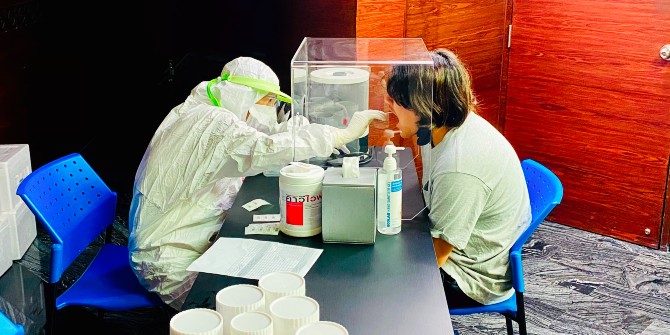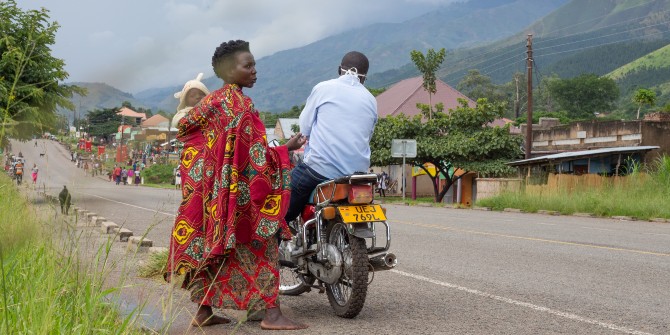As countries struggle to contain COVID outbreaks, contact tracing continues to be vital. Researchers from the Thai Ministry of Public Health, National University of Singapore, World Health Organisation and LSE explain how they have developed a new approach to assessing its effectiveness and share some early findings from Thailand.
In recent months, vaccines have dominated the discourse on ending the pandemic. This does not mean that contact tracing is obsolete. Limited vaccine supplies and the spectre of new variants continue to make contact tracing a very relevant and necessary intervention. Many countries are in the throes of a surge in COVID cases even as they roll out ambitious vaccination programmes. This means that contact tracing is playing a major role in containing the spread of the virus.
Often referred to within the context of “test, trace and isolate”, contact tracing involves identification and monitoring of contacts, and providing support to those exposed to the virus. Experience during pandemics suggests that it is an effective measure to limit transmission of the disease.
However, efforts to reach all the contacts of an infected person can mean that the process takes too long, and people continue to spread the disease before they are told to self-isolate. The use of contact tracing apps during the COVID pandemic has revolutionised this approach by facilitating contact identification in a timely and accurate manner. Nonetheless, the reliance on these apps has raised a number of privacy and equity concerns.
Typical indicators to measure the success of contact tracing tend to focus on efficiency. Few consider the implications for equity. This is pertinent, as the impact of COVID has been uneven: older people, as well as those who are poor or from historically marginalised or socially excluded groups, have been more affected. These groups may lack access to healthcare, making them more vulnerable to the effects of the disease. Privacy concerns are heightened among groups that may be wary of contact tracing, due to previous interactions with government agencies.
To better understand the trade-offs between efficiency and equity attributes in contact tracing, a research team from the Saw Swee Hock School of Public Health, National University of Singapore (SSHSPH NUS), the Health Intervention and Technology Assessment Program (HITAP) Thailand, LSE and the World Health Organisation Southeast Asia Regional Office (WHO SEARO) will survey a global audience of contact tracers, policymakers and practitioners, to learn about their preferences in contact tracing and develop guidance for policymakers.
A Discrete Choice Experiment (DCE) approach will be used to elicit these preferences. Respondents will be asked to trade-off six attributes defining the design of a contact tracing strategy: the completeness of contacts traced; the timeliness of contacts traced; the cooperation of cases and their contacts with contact tracers; the level of privacy accorded to COVID cases and their contacts by requiring mandatory or voluntary reporting to authorities; prioritising vulnerable groups who may be susceptible to having more severe symptoms of the disease; and prioritising groups that have more contacts. These attributes will be assessed in a given epidemiological context.

Early findings from interviews with contact tracers and policymakers in Thailand have been revealing. Eliciting accurate information from those infected with COVID can be challenging. Ensuring that the app is easy to use both for those reporting and those using the data is important if contact tracing is to be effective. Adequate staffing for contact tracing is a key constraint, and while there is a statutory requirement to have at least one disease prevention and control operations unit in each district, in densely populated areas this has not been enough. Traditional metrics of fairness — such as prioritising contacts to trace based on the rural and urban divide, or socio-economic class — were given little weight relative to efficiency metrics such as tracing all the contacts of cases and reaching them as quickly as possible. In migrant communities structural barriers, such as language and the availability of resources for testing, remain. The costs of testing and the loss of income during the self-isolation period can be a particularly acute pain point for low-income groups, a cost which may need to be defrayed by governments. These types of issues need to be weighed against others when designing a successful contact tracing policy that breaks the chain of transmission.
Contact tracing will guide policymakers through the end of the pandemic, especially as countries brace for a surge in cases or adapt to a “new normal” where it will become a routine and essential intervention. A greater understanding of the equity implications of contact tracing and guidance on how these could be applied to policy will help tackle both current and future pandemics.
If you would like to learn more about or participate in the study, contact us using this form. The study is supported by WHO SEARO and the International Decision Support Initiative (IDSI). The authors are members of the research team, which also includes Yot Teerawattananon from HITAP and SSHSP NUS; Rapeepong Suphanchaimat from the International Health Policy Program (IHPP), who is a supervisor on the project; Chua Hui Lan from SSHSP NUS, and Supanun Kawsud from HITAP, who are managing the project at their respective organisations. HITAP is a member of the Global Outbreak Alert and Response Network (GOARN).
This post represents the views of the authors and not those of the COVID-19 blog, nor LSE.





